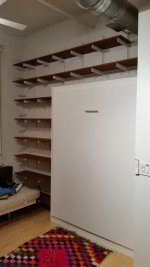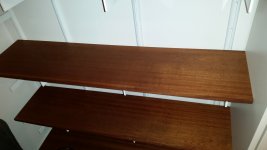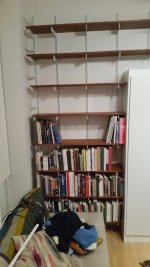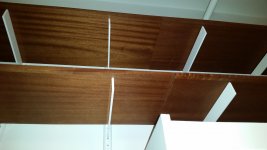So I finished up the project today. Went with a shelving system by Rakks -- Q style wall standard and heavy duty 2" brackets. I was able to address the concerns about the weight by bringing the tall standards all the way down to rest on the baseboard. With one exception, all the standards are also tied into the metal studs in the drywall, spaced at 16" intervals, so there should be plenty of support. I was originally going to use the Snap toggles mentioned earlier in the thread, but unfortunately the standards are sized for smaller fasteners, and drilling them out for a 3/16" bolt (minimum size for snap toggle) would have chewed into the face of the standard. So I just went with regular toggle bolts.
The shelves are Sapele veneered ply with a hardwood edge, finished with Osmo.
Installation took a long time. This was partly because I had to slightly widen every hole to make sure the metal stud didn't impede the toggle. But it was also because of the design of the system, which makes aligning all the brackets a tedious task. More time was also spent carefully drilling two holes on the underside of each board at either end into which pins on the end brackets are inserted for extra shelf stability.
For anyone interested in the Rakks system, I just wanted to alert you to what seems like a major design flaw (at least for the heavy-duty Q standards -- can't speak for the others). The brackets have no preset position. Rather, you slide them up or down to the desired height, and then wedge them down into a 90 degree angle. They are designed to fit so tight that the act of wedging them creates a small indentation in the standard, which thereafter acts almost like a positive stop on a miter gauge or saw scale. If you try to reset it within an 1/8" of that indentation, the bracket pops back into the spot where you initially set it. So you have to be really careful when doing small adjustments, otherwise you will have to completely reset that run of brackets at least 1/4" up or down from the original spot. Problem is that because you slide the bracket up and down at an angle, it's difficult to tell exactly where the bracket will end up when you pop it into the final 90 degree position. So be ready for a patience-testing afternoon.






